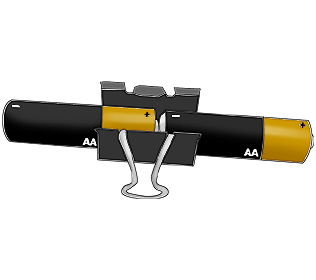 | ||
| || home ||| units ||||| help | ||
| All Units | > | Unit 2 - Electricity | > | Investigation 1 - Batteries and conductors | > | Trial 1 |
Trial 1 - Messing Around
-
A battery can push electric charge like a pump can push water through a hose. The strength of a battery's pumping ability is called voltage. Obtain some batteries from your teacher.
-
Draw a picture of each battery. Refer to Technical Hints to see how to use the drawing tool.

-
Use your voltage sensor to measure the voltage across one of the batteries as shown in the picture. Missing picture Make sure to connect the red end of the sensor to the positive end (+) of the battery and the black end of the sensor to the negative end (-) of the battery. Refer to Technical Hints to connect the voltage sensor. Record the voltage next to your drawing of the battery.
-
Record the voltage for all of the batteries and rank the batteries from highest voltage to lowest voltage.

-
Flashlights, electronic game players or CD players sometimes use more than one battery. If you connect two batteries together positive (+) end of one battery to negative (-)end of the other battery, what do you think happens to the voltage?

-
Obtain 2 good AA batteries. Use the voltage sensor to measure the voltage across each of the batteries. Refer to Technical Hints to connect the voltage sensor.
Battery 1 Voltage:

Battery 2 Voltage:

-
Connect the two AA batteries together using the binder clip as shown below. The positive end (+) of one battery needs to connect to the negative end (-) of the other. Make sure you push the batteries together so that they are touching each other.

-
Measure the voltage of the two batteries together. Refer to Technical Hints to connect the voltage sensor.
Voltage across battery 1: recorded earlier
Voltage across battery 2: recorded earlier
Voltage across both batteries:

-
Do you see any pattern between each batteries individual voltage and the combined voltage? Explain. Be prepared to share your results with the class.

 |  |  |
Copyright 2005 The Concord Consortium, All rights reserved.